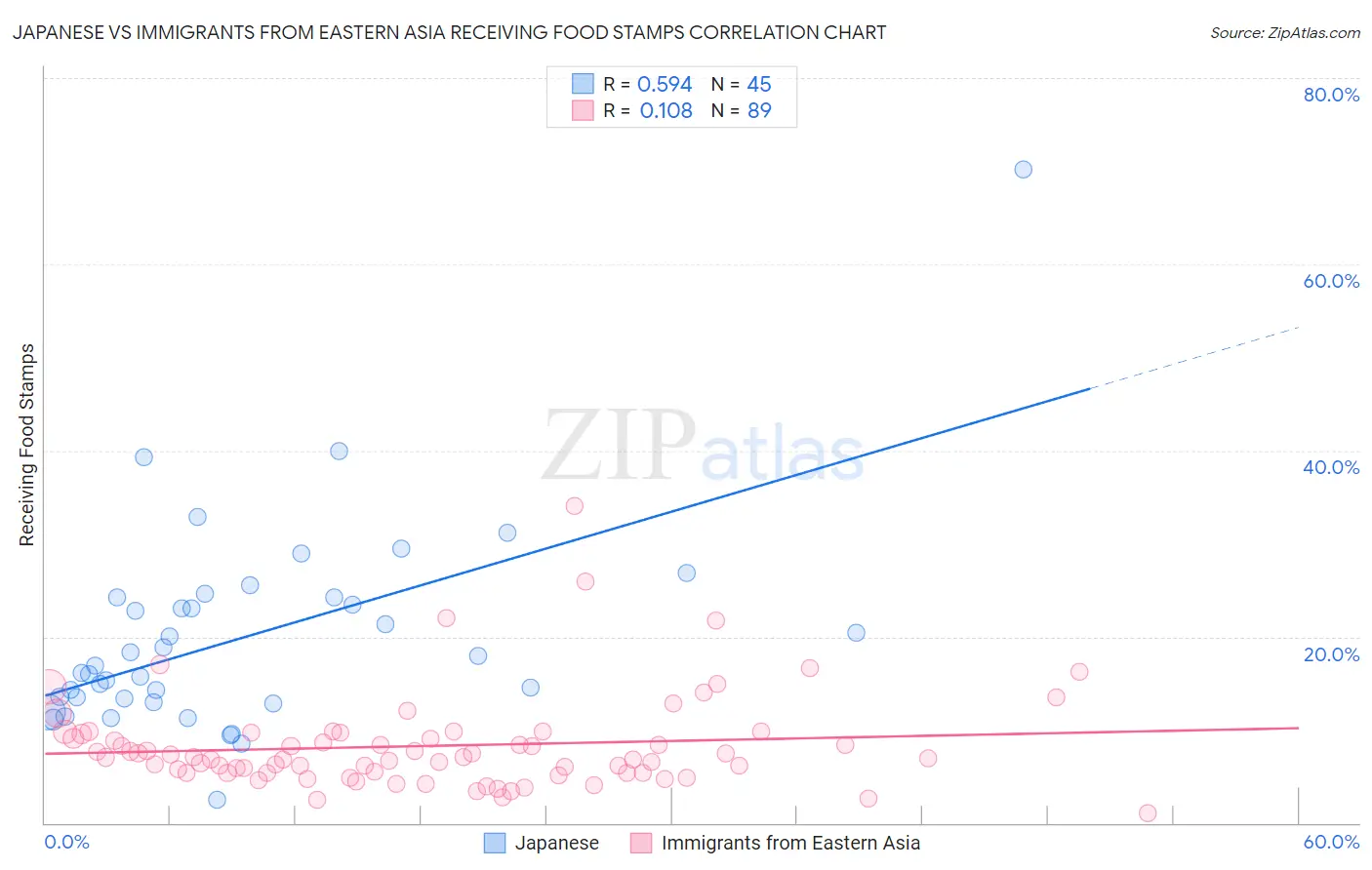Japanese vs Immigrants from Eastern Asia Receiving Food Stamps
COMPARE
Japanese
Immigrants from Eastern Asia
Receiving Food Stamps
Receiving Food Stamps Comparison
Japanese
Immigrants from Eastern Asia
14.1%
RECEIVING FOOD STAMPS
0.3/ 100
METRIC RATING
256th/ 347
METRIC RANK
9.3%
RECEIVING FOOD STAMPS
99.7/ 100
METRIC RATING
31st/ 347
METRIC RANK
Japanese vs Immigrants from Eastern Asia Receiving Food Stamps Correlation Chart
The statistical analysis conducted on geographies consisting of 248,870,971 people shows a substantial positive correlation between the proportion of Japanese and percentage of population receiving government assistance and/or food stamps in the United States with a correlation coefficient (R) of 0.594 and weighted average of 14.1%. Similarly, the statistical analysis conducted on geographies consisting of 497,431,839 people shows a poor positive correlation between the proportion of Immigrants from Eastern Asia and percentage of population receiving government assistance and/or food stamps in the United States with a correlation coefficient (R) of 0.108 and weighted average of 9.3%, a difference of 51.2%.

Receiving Food Stamps Correlation Summary
| Measurement | Japanese | Immigrants from Eastern Asia |
| Minimum | 2.5% | 1.0% |
| Maximum | 70.2% | 34.0% |
| Range | 67.7% | 33.0% |
| Mean | 19.9% | 8.3% |
| Median | 16.8% | 7.0% |
| Interquartile 25% (IQ1) | 13.1% | 5.4% |
| Interquartile 75% (IQ3) | 24.2% | 9.6% |
| Interquartile Range (IQR) | 11.1% | 4.2% |
| Standard Deviation (Sample) | 11.1% | 5.1% |
| Standard Deviation (Population) | 10.9% | 5.1% |
Similar Demographics by Receiving Food Stamps
Demographics Similar to Japanese by Receiving Food Stamps
In terms of receiving food stamps, the demographic groups most similar to Japanese are Subsaharan African (14.1%, a difference of 0.020%), Marshallese (14.1%, a difference of 0.030%), Arapaho (14.1%, a difference of 0.10%), Immigrants from Ghana (14.1%, a difference of 0.18%), and Creek (14.1%, a difference of 0.30%).
| Demographics | Rating | Rank | Receiving Food Stamps |
| Indonesians | 0.6 /100 | #249 | Tragic 13.9% |
| Immigrants | Cambodia | 0.5 /100 | #250 | Tragic 13.9% |
| Yaqui | 0.5 /100 | #251 | Tragic 13.9% |
| Ghanaians | 0.5 /100 | #252 | Tragic 14.0% |
| Spanish Americans | 0.4 /100 | #253 | Tragic 14.0% |
| Marshallese | 0.3 /100 | #254 | Tragic 14.1% |
| Sub-Saharan Africans | 0.3 /100 | #255 | Tragic 14.1% |
| Japanese | 0.3 /100 | #256 | Tragic 14.1% |
| Arapaho | 0.3 /100 | #257 | Tragic 14.1% |
| Immigrants | Ghana | 0.3 /100 | #258 | Tragic 14.1% |
| Creek | 0.3 /100 | #259 | Tragic 14.1% |
| Central Americans | 0.3 /100 | #260 | Tragic 14.1% |
| Immigrants | Congo | 0.3 /100 | #261 | Tragic 14.1% |
| Paiute | 0.2 /100 | #262 | Tragic 14.3% |
| Immigrants | Portugal | 0.2 /100 | #263 | Tragic 14.3% |
Demographics Similar to Immigrants from Eastern Asia by Receiving Food Stamps
In terms of receiving food stamps, the demographic groups most similar to Immigrants from Eastern Asia are Bolivian (9.3%, a difference of 0.31%), Immigrants from Sweden (9.3%, a difference of 0.41%), Immigrants from Lithuania (9.2%, a difference of 0.78%), Czech (9.2%, a difference of 1.1%), and Bhutanese (9.2%, a difference of 1.1%).
| Demographics | Rating | Rank | Receiving Food Stamps |
| Immigrants | Northern Europe | 99.8 /100 | #24 | Exceptional 9.2% |
| Immigrants | Ireland | 99.8 /100 | #25 | Exceptional 9.2% |
| Swedes | 99.8 /100 | #26 | Exceptional 9.2% |
| Bhutanese | 99.8 /100 | #27 | Exceptional 9.2% |
| Czechs | 99.8 /100 | #28 | Exceptional 9.2% |
| Immigrants | Lithuania | 99.8 /100 | #29 | Exceptional 9.2% |
| Immigrants | Sweden | 99.7 /100 | #30 | Exceptional 9.3% |
| Immigrants | Eastern Asia | 99.7 /100 | #31 | Exceptional 9.3% |
| Bolivians | 99.7 /100 | #32 | Exceptional 9.3% |
| Zimbabweans | 99.6 /100 | #33 | Exceptional 9.5% |
| Turks | 99.6 /100 | #34 | Exceptional 9.5% |
| Immigrants | Austria | 99.6 /100 | #35 | Exceptional 9.5% |
| Estonians | 99.6 /100 | #36 | Exceptional 9.5% |
| Europeans | 99.6 /100 | #37 | Exceptional 9.5% |
| Immigrants | Sri Lanka | 99.5 /100 | #38 | Exceptional 9.5% |